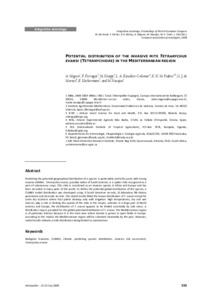| dc.contributor.author | Bertrand, M. |
| dc.contributor.author | Kreiter, S. |
| dc.contributor.author | Mc Coy, k.D. |
| dc.contributor.author | Migeon, A. |
| dc.contributor.author | Navajas, M. |
| dc.contributor.author | Tixier, M.S. |
| dc.contributor.author | Vial, L. |
| dc.date.accessioned | 2019-12-04T11:15:04Z |
| dc.date.available | 2019-12-04T11:15:04Z |
| dc.date.issued | 2008 |
| dc.identifier.citation | Bertrand, M., Kreiter, S., Mc Coy, k.D., Migeon, A., Navajas, M., Tixier, M.S. & Vial, L. (Eds.). (2008). Potential distribution of invasive mite Tetranychus evansi (Tetranychidae) in Mediterranean region: Proceedings of the 6th European Congress–Integrative Acarology, Montpellier, 21-25 July 2008. Montpellier: Integrative Acarology. |
| dc.identifier.uri | https://hdl.handle.net/20.500.12478/2910 |
| dc.description.abstract | Predicting the potential geographical distribution of a species is particularly useful for pests with strong invasive abilities. Tetranychus evansi, possibly native of South America, is a spider mite recognized as a pest of solanaceous crops. This mite is considered as an invasive species in Africa and Europe and has been recorded in many parts of the world. To define the potential global distribution of the species, a CLIMEX model distribution was developed using: i) South American records, ii) laboratory life‐history parameters and iii) exotic records. The model results fitted the known distribution of T.evansi Except for some dry locations host plants develop only with irrigation. High temperatures, dry and wet stresses play a role in limiting the spread of the mite in the tropics, Whereas in a large part of North America and Europe, the distribution of T.evansi appears to be limited essentially by cold stress. A distribution map is provided for the global potential distribution of T.evansi. The Mediterranean region is of particular interest because it is the main area where tomato is grown in open fields in Europe.
According to the model, the Mediterranean region will be colonized in exorably by the pest. However, model results indicate a mite distribution being limited to coastal areas. |
| dc.language.iso | en |
| dc.subject | Biological Invasions |
| dc.subject | Climex |
| dc.subject | Climate |
| dc.subject | Predicting Species Distribution |
| dc.subject | Invasion Risk Assessment |
| dc.subject | Tetranychus Evansi |
| dc.title | Potential distribution of the invasive mite Tetranychus evansi (Tetranychidae) in the Mediterraean region |
| dc.type | Conference Proceedings |
| dc.description.version | Peer Review |
| cg.contributor.affiliation | Universidad Politecnica de Valencia |
| cg.contributor.affiliation | African Insect Science for Food and Health |
| cg.contributor.affiliation | Estacio Experimental Agricola Mas Badia |
| cg.contributor.affiliation | International Institute of Tropical Agriculture |
| cg.contributor.affiliation | Departemento de Entomologia |
| cg.contributor.affiliation | Plant Protection Research Institute |
| cg.coverage.region | Acp |
| cg.coverage.region | Africa |
| cg.coverage.region | Europe |
| cg.coverage.region | East Africa |
| cg.coverage.region | South America |
| cg.coverage.region | Southern Africa |
| cg.coverage.country | France |
| cg.coverage.country | Spain |
| cg.coverage.country | Kenya |
| cg.coverage.country | Uganda |
| cg.coverage.country | Brazil |
| cg.coverage.country | South Africa |
| cg.authorship.types | CGIAR and developing country institute |
| cg.iitasubject | Agribusiness |
| cg.iitasubject | Climate Change |
| cg.iitasubject | Pests Of Plants |
| cg.iitasubject | Domestic Trade |
| cg.iitasubject | Handling, Transport, Storage And Protection Of Agricultural Products |
| cg.iitasubject | Plant Health |
| cg.iitasubject | Food Security |
| cg.iitasubject | Markets |
| cg.iitasubject | Diseases Control |
| cg.iitasubject | Plant Diseases |
| cg.iitasubject | Plant Production |
| cg.accessibilitystatus | Limited Access |
| local.dspaceid | 94011 |

